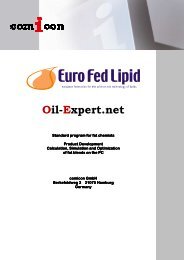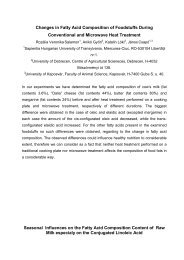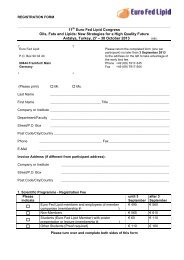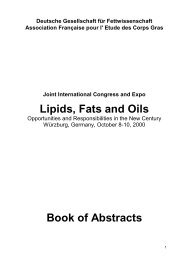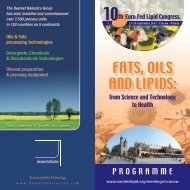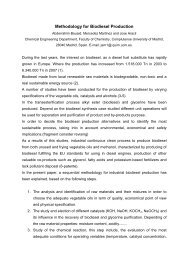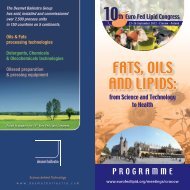Abstracts now available online - Euro Fed Lipid
Abstracts now available online - Euro Fed Lipid
Abstracts now available online - Euro Fed Lipid
Create successful ePaper yourself
Turn your PDF publications into a flip-book with our unique Google optimized e-Paper software.
Extracellular BODYGUARD involved in the formation of cuticle<br />
Alexander Yephremov 1 , Andrea Faust 1 , Derry Voisin 1 , Sergey Kurdyukov 1 , Christiane<br />
Nawrath 2 , Nadia Efremova 1 , Rochus Franke 3 , Lukas Schreiber 3 , Heinz Saedler 1<br />
1<br />
Max-Planck-Institut für Züchtungsforschung, Carl von Linné Weg 10, 50829 Köln,<br />
Germany; 2 Département de Biologie Moléculaire Végétale, Université de Lausanne,<br />
CH-1015 Lausanne, Switzerland; 3 Institut für Zelluläre and Molekulare Botanik,<br />
Universität Bonn, Kirschallee 1, D-53115 Bonn, Germany.<br />
The extracellular matrix produced by epidermal cells is specialized to protect plants<br />
against adverse environmental conditions and pathogens and includes the cuticle<br />
barrier the outermost cell wall of the epidermis made up of lipid molecules. Some<br />
extracellular lipids are soluble and can be extracted with organic solvents into the wax<br />
fraction, while others are connected to cell wall carbohydrates and interconnected by<br />
ester bonds. A number of Arabidopsis mutants, which show apparent defects in the<br />
cuticular barrier, represent a valuable genomic tool not only to identify genes involved in<br />
the formation of the cuticle but also to elucidate how cuticular lipids modulate<br />
development of plants. Here we report characterization of an Arabidopsis cuticular<br />
mutant, called bodyguard (bdg), which displays pleiotropical effects of the mutation on<br />
growth, morphology, cell viability and differentiation. The bdg mutant accumulates<br />
significantly more cell wall-bound lipids and epicuticular waxes than wild-type plants.<br />
The RT-PCR analysis shows in bdg transcriptional activation of genes involved in the<br />
decarbonylation pathway, which catalyzes the formation of alkanes with odd-numbered<br />
chain lengths in epicuticular wax. However, with regard to cuticular appearance and<br />
structure, bdg is reminiscent to transgenic Arabidopsis plants expressing extracellular<br />
fungal cutinase, which exhibit defects characteristic of loss of cuticle structure.<br />
Strikingly, molecular cloning of BDG shows that it encodes a member of the α/βhydrolase<br />
fold superfamily of proteins, to which extracellular fungal cutinases belong.<br />
Expression of BDG is restricted to epidermal cells. Furthermore, subcellular<br />
immunolocalization shows that BDG is a polarly localized protein that accumulates in<br />
the outermost cell wall in the epidermis. Thus, BDG defines a new family of plantspecific<br />
α/β hydrolases. We propose that BDG is required for polymerization processes<br />
in the cuticular layer of the cell wall or the cuticle proper.




